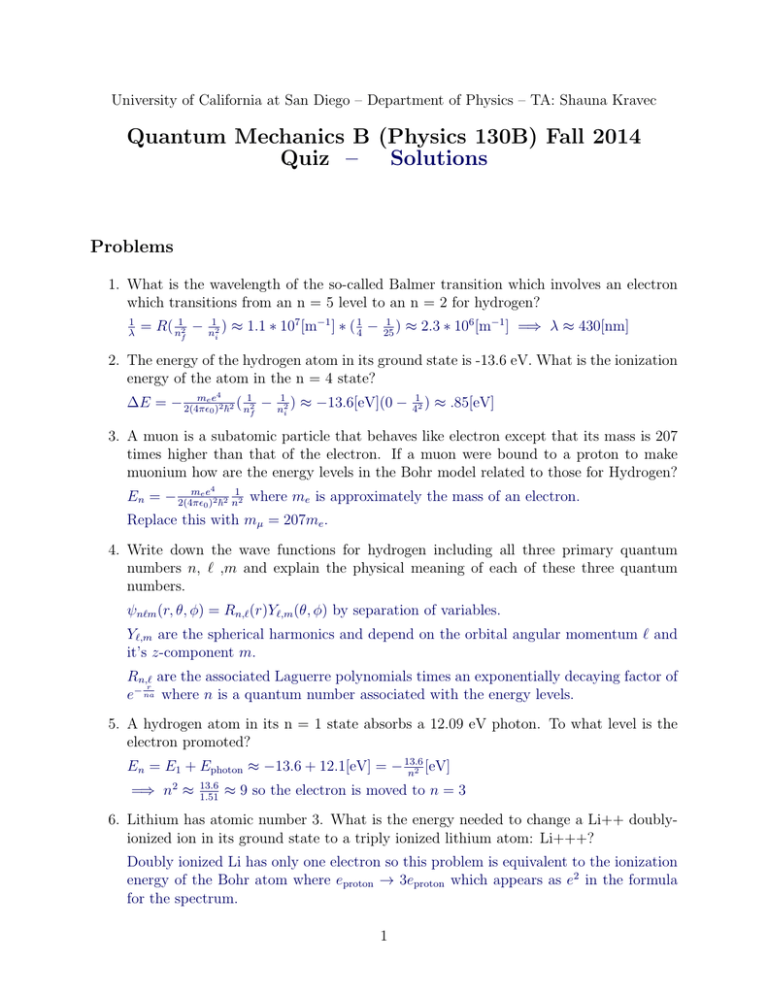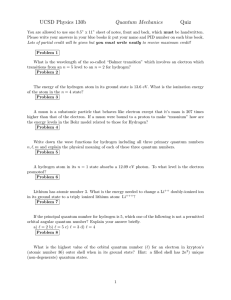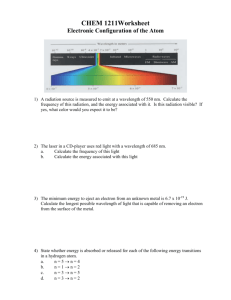Quantum Mechanics B (Physics 130B) Fall 2014 Quiz – Solutions
advertisement

University of California at San Diego – Department of Physics – TA: Shauna Kravec
Quantum Mechanics B (Physics 130B) Fall 2014
Quiz –
Solutions
Problems
1. What is the wavelength of the so-called Balmer transition which involves an electron
which transitions from an n = 5 level to an n = 2 for hydrogen?
1
λ
= R( n12 −
f
1
)
n2i
≈ 1.1 ∗ 107 [m−1 ] ∗ ( 41 −
1
)
25
≈ 2.3 ∗ 106 [m−1 ] =⇒ λ ≈ 430[nm]
2. The energy of the hydrogen atom in its ground state is -13.6 eV. What is the ionization
energy of the atom in the n = 4 state?
4
me e
1
∆E = − 2(4π
2 2 ( n2 −
0) ~
f
1
)
n2i
≈ −13.6[eV](0 −
1
)
42
≈ .85[eV]
3. A muon is a subatomic particle that behaves like electron except that its mass is 207
times higher than that of the electron. If a muon were bound to a proton to make
muonium how are the energy levels in the Bohr model related to those for Hydrogen?
4
me e
1
En = − 2(4π
2 2 2 where me is approximately the mass of an electron.
0) ~ n
Replace this with mµ = 207me .
4. Write down the wave functions for hydrogen including all three primary quantum
numbers n, ` ,m and explain the physical meaning of each of these three quantum
numbers.
ψn`m (r, θ, φ) = Rn,` (r)Y`,m (θ, φ) by separation of variables.
Y`,m are the spherical harmonics and depend on the orbital angular momentum ` and
it’s z-component m.
Rn,` are the associated Laguerre polynomials times an exponentially decaying factor of
r
e− na where n is a quantum number associated with the energy levels.
5. A hydrogen atom in its n = 1 state absorbs a 12.09 eV photon. To what level is the
electron promoted?
En = E1 + Ephoton ≈ −13.6 + 12.1[eV] = − 13.6
[eV]
n2
=⇒ n2 ≈
13.6
1.51
≈ 9 so the electron is moved to n = 3
6. Lithium has atomic number 3. What is the energy needed to change a Li++ doublyionized ion in its ground state to a triply ionized lithium atom: Li+++?
Doubly ionized Li has only one electron so this problem is equivalent to the ionization
energy of the Bohr atom where eproton → 3eproton which appears as e2 in the formula
for the spectrum.
1
4
me e
1
Eionization = Z 2 2(4π
2 2 2 ≈ 9 ∗ 13.6[eV]
0) ~ n
7. If the principal quantum number for hydrogen is 5, which one of the following is not a
permitted orbital angular quantum number? Explain your answer briefly.
{` = 2, ` = 5, ` = 3, ` = 4}
` = 5 is not allowed when n = 5 as the range of permissible ` ∈ {0, 1, · · · , n − 1}
8. What is the highest value of the orbital quantum number ` for an electron in Krypton’s
(Z = 36) outer shell when in its ground state?
(Hint: Filled shells have 2n2 distinct states)
The factor of 2 in the state counting is due to the fact elecrons have a spin quantum
number in addition to n, `, m
Krypton should have 36 electrons and in its ground state they occupy the various
orbitals/shells starting from the lowest energies and ascending.
n = 1, 2, 3 are completely filled as there are 2 + 8 + 18 = 28 states.
The remaining 8 electrons occupy the 4s and 4p orbitals. This is the ’outer shell’. The
4p orbital has ` = 1 so that is the highest ` occupied by any electron in this shell.
Note that this completely fills the 4p orbital. This is to be expected as Krypton is a
noble gas.
One possible pitfall is to correctly conclude n = 4 is the outer shell but then say
` = n − 1 = 3 is the highest value of `.
While certainly it is the largest angular momentum available to any electron at n = 4
the degeneracy in ` is broken by generic perturbation/interactions. Thus they will
prefer lower ` states as they will be lower in energy. This can be quite dramatic;
electrons will sooner occupy 4s than 3d for simple atoms.
Partial credit was awarded for the answer of ` = 3
2








